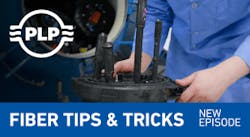Part 3. Understanding Crossed Battery and Your Advanced Test Set Features —
To recap, for this 3-part series on Cable Fault Locating and Repair, in the June issue we ran Part 1 providing a review of short-term versus long-term approaches. In the July issue, with Part 2, I provided processes I employ and teach to help technicians integrate advanced fault locating techniques using longitudinal balance and other functions of a multi-function test set.
In this month’s column, the final part of my 3-part series on evidence-based best practices for Cable Fault Locating and Repair, we consider the complex topic and process of crossed battery, and how to maximize use of your digital multimeter and TDR, RFL, and open meter functions.
When the longitudinal balance function of your multimeter fails, the next step is to determine the cause of failure on a copper cable pair. Now it’s time to employ the DMM to determine what the cause is and then use the resistive fault locater (RFL) function in conjunction with the open meter and the time domain reflectometer (TDR) function to identify the location of the fault along the cable route. Here’s a process that may work for you:
InvisiLight® Solution for Deploying Fiber
April 2, 2022Go to Market Faster. Speed up Network Deployment
April 2, 2022Episode 10: Fiber Optic Closure Specs Explained…
April 1, 2022Food for Thought from Our 2022 ICT Visionaries
April 1, 2022DISCOVER THE ROOT CAUSE
To discover the root cause of a cable pair fault, first test the pair for any hazardous AC voltage.
• A digital AC voltmeter usually displays RMS voltage. For example, 120VAC peak feeds an AC outlet. The digital AC volt meter displays 110VAC RMS voltage.
• When testing any cable pair working or not for AC voltage, expect to see from .2VAC to 10VAC. Any AC voltage greater than 50VAC is potentially hazardous. When encountered follow your company’s safety practices.
TEST THE PAIR
Next, test the pair to see if unwanted crossed battery is the root cause.
• Test for DC voltage tip and ring to ground. A DC voltmeter measures the DC voltage drop across any two points of an electric circuit. This is an 0hms per volt network.
• A 1 meg-ohm resister is placed in series and a voltage drop across the resistor is displayed or indicated on the volt meter. For example, the applied tip to ring battery on a class-5 POTS switch will range from -48VDC to -56VDC depending on the type of switch. The old step-by-step mechanical switch applied -48VDC across ring to tip and a #5 ESS switch applies -51VDC across ring to tip.
• If you were to measure the applied voltage at the vertical main frame, a cross-box, any pedestal, any network, on a class-#5 ESS switch, the applied voltage ring to tip indicated on a volt meter would show -51VDC.
CROSSED BATTERY: INDICATED vs. APPLIED BATTERY
The topic of crossed battery is an important lesson, and many aren’t sure of how to proceed so I want to spend some time on this topic.
When the vacant pair that you are testing shows any crossed-battery tip and/or ring to ground, the indicated battery is usually less than the applied battery coming from other working cable pairs. Crossed battery can be caused by sheath damage, water in air core cable, and water in a splice.
• So how do you make sense of and deal with crossed battery?
• What do you do with the test results when indicated vs. applied battery are so different?
CROSSED BATTERY WHEN THERE IS WATER IN THE PAIR
Following is an example of crossed battery when there is water in the pair. Here’s how to determine exactly what you are dealing with:
• When testing vacant cable pairs, ring and/or tip to ground for crossed-battery on vacant pairs, DC voltage may range from as little as -3VDC to as much as -45 VDC. That is because when there is water in the pair, series resistance to ground is added to the 1 meg-ohm resister in the ohms per volt network. Therefore, even though your volt meter indicates low voltage, the applied voltage is at least -48VDC.
• Next, determine if the failure is in one pair or whether it’s total cable failure by testing all pairs in the 25 pair sub unit. If crossed-battery is indicated on other pairs in your 25 pair sub-unit, the root cause is a cable failure.
• Now test for crossed-battery in other sub-units to determine the magnitude of the cable failure. If no crossed-battery is indicated when testing other vacant pairs, select the ohms function on the test set DMM and then test the pair tip to ring ohms, tip to ground ohms, and ring to ground ohms. Any crossed-battery fault indicating more than -3VDC or any resistive fault that is more solid than 20 megohms can be located with the RFL function of the multi-function test set.
FIND OUT WHERE THE PROBLEM IS
So now that you know what the problem is, let’s explore how to use the RFL to find out where the problem is:
• When using the RFL function on the test set with a single pair hookup or a separate good pair hookup, results will provide the resistance to the far end strap; the resistance to the fault from the test set; and the resistance from the far end strap to the fault on the cable pair in ohms.
• To continue the example of water in the pair, when testing at the cross-box with the pair open, we have identified a -6VDC ring battery-cross and the tip conductor tests good. Now you must obtain an open measurement. The tip side may test good because it is open 300 feet away. In my example, the tip side shows the tip conductor open at 4,100 feet which is approximately the distance to the customer’s terminal.
• Next, strap the pair tip to ring at the cross-box and proceed to the customer’s terminal. At the customer’s terminal we prove the fault into the cable and we use the time domain reflectometer (TDR) to identify the strap is good at the cross-box and the distance to shorted cable pair measures 3,900 feet with the TDR.
• After running the RFL function with a single pair hookup, we measure resistance to strap (RTS) 102 ohms, resistance to fault (RTF) 14 ohms, and resistance strap to fault (RSTF) 88 ohms. To determine the resistance to the strap (RTS) when using a single pair hookup, the test set measures tip to ring ohms to the far end strap and divides that resistance in half. To determine the RTF, the test set runs current through the fault. A percentage of the total current flows back to the test set and the other percentage of the total current flows to the far end strap with the test set being 0% of the total current flow and the far end strap being 100% of the total current flow. In our example, 14% of the total current flow is 14 ohms RTF and 88 ohms RSTF.
• The advantage of a constant current flow measurement is that the amount of current flow through the fault can change with more or less current flow but the percentage of current flow to the test set and the far end strap remains the same for very accurate RTF and RSTF measurements to the fault. When the RFL measurement is displayed measure again several times. RTF and RSTF should remain the same. If they change, the conductor that you are measuring is faulted in more than one spot and any displayed measurement will take you in between the two measurements depending upon which of the two measurements is more solid.
• Now the RFL measurements can be converted from ohms to feet or meters by switching to feet or meters by setting in the gauge and temperature of the cable. Keep in mind that if there is a gauge or a temperature change, it must be accounted for. You can convert ohms to feet or meters, calculate temperature and gauge change by using the multi gauge or temperature feature in the RFL function of your test set.
CONCLUSION
In my 40 years of teaching, I’ve found that crossed battery issues and processes for how to use equipment and interpret test results are confusing and complicated for most technicians.
This is the point where many good technicians back out and take the easy route: falling back on "cut to clear." Please reconsider, because when you take the easy route you are wasting valuable resources.
Learn the hard lesson — because it is actually fun, challenging, and becomes easier to do as you do it over and over.
Like this Article?
Subscribe to ISE magazine and start receiving your FREE monthly copy today!
Signing off
I spend an entire day on the topic of crossed battery during my 4-day course. Therefore, if you are still unclear about how to implement the process as I’ve described, please don’t be shy about asking for further clarification. I’m trying to describe in a page what I spend an entire day teaching. Every question or comment is a smart one — and something many others probably wish someone would ask. So, fire away! You can reach me at [email protected] or text or call 831.818.3930.
To read the first 2 articles in the series:
Part 1. Short-Term and Long-Term Approaches, please visit https://isemag.com/2020/06/telecom-cable-fault-locating-and-repair-part1/.
Part 2. Identifying a Faulted Pair, please visit https://isemag.com/2020/07/telecom-part-2-identifying-a-faulted-pair/.
About the Author





